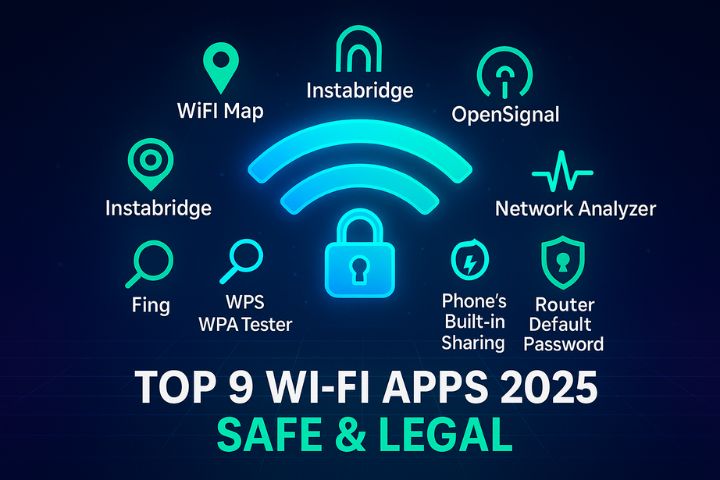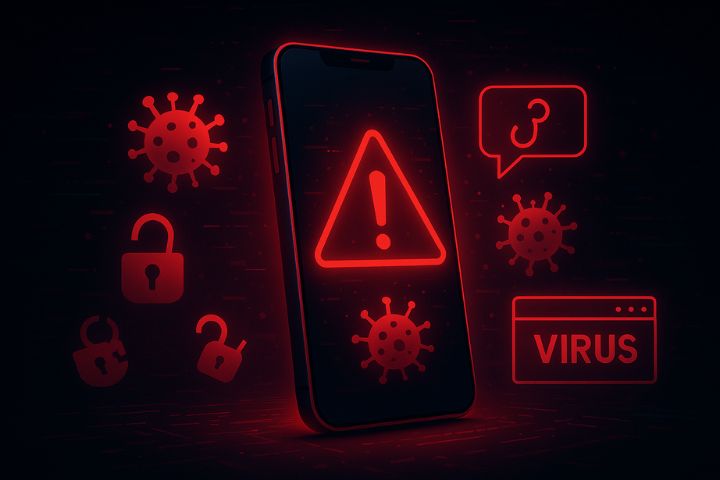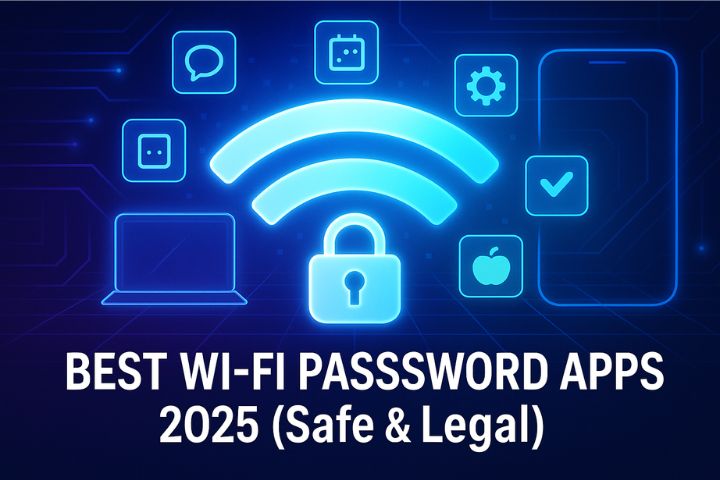Looking for the best Wi-Fi password app in 2025? You’re not alone. Every day, thousands of users search for quick ways to connect, whether it’s recovering a saved password, finding a safe public hotspot, or sharing Wi-Fi with friends. But here’s the truth: no app can magically hack Wi-Fi passwords protected by WPA2/WPA3.
Instead, there are trusted Wi-Fi tools designed to help you find public hotspots, share your own connection safely, recover forgotten passwords on your devices, and even secure your home router. In this guide, we’ll explore the top Wi-Fi apps in 2025, compare tools like WiFi Map vs Instabridge, and show you how to stay connected legally and securely. For the full breakdown, check the Wi-Fi Password Pillar Guide.
Bottom line: This guide recommends safe, legal apps and shows how to avoid risky APKs pretending to “hack” Wi-Fi.
What Counts As a “Wi-Fi Password App”?
Safe categories (legit use-cases):
- Hotspot directories: community-shared networks (e.g., cafés that publish access).
- Sharing helpers: generate QR codes or share credentials with permission.
- Recovery helpers: show saved passwords on your own devices.
- Diagnostics: check signal quality, channel congestion, and router basics.
- Security testing (your own network): assess weak defaults and old standards.
Unsafe categories (avoid):
- “One-click hack” apps, Mangoai-branded APKs, survey-wall “unlockers.” These usually deliver ads, malware, or phishing—not passwords.
How To Spot a Trustworthy App?
- Store listing only: Google Play / Apple App Store (no random APK sites).
- Transparent developer: known publisher, real website, contact email.
- Reasonable permissions: no SMS, mic, camera, or contacts if not essential.
- Reviews & recency: 4.0+ rating, recent updates, meaningful user comments.
- No hack claims: language focuses on finding public Wi-Fi, sharing, diagnostics—not “hacking.”
The Top 9 Wi-Fi Apps & Tools in 2025 (Safe & Legal)

Use these responsibly and legally. Always ask permission before joining private networks.
1) WiFi Map (Android/iOS)
Best for: travelers who need vetted public hotspots
What it does: community-shared Wi-Fi locations, tips, sometimes posted passwords.
Pros: massive global database, maps, offline lists for travel.
Cons: user-posted details can be outdated; always verify network name with staff.
How to use: Search the city/area → tap a hotspot → read notes → connect if it’s public/approved.
Great pairings: VPN app for safer browsing on public networks.
2) Instabridge (Android/iOS)
Best for: plug-and-play public Wi-Fi access
What it does: community sharing + automatic connection to shared hotspots where available.
Pros: clean UI, auto-connect, solid in major cities.
Cons: coverage varies; treat posted details as tips, not guarantees.
How to use: Allow location → see nearby options → auto-connect to approved networks.
3) OpenSignal (Android/iOS)
Best for: comparing Wi-Fi vs mobile coverage and speeds
What it does: maps network performance, finds strong coverage zones.
Pros: unbiased performance data; great for picking the best spot to work.
Cons: not a password tool—focus is analytics.
How to use: Open the map → locate fastest zones → decide where to sit for better Wi-Fi.
4) Network Analyzer (Android/iOS; various vendors)
Best for: deeper diagnostics
What it does: shows signal strength, channel usage, DNS, gateway, and basic scans.
Pros: ideal for fixing home Wi-Fi or verifying a venue’s setup.
Cons: technical output—beginner learning curve.
How to use: Run a scan → note signal (RSSI), channel overlap → ask the venue to move channels if congested.
5) Fing (Android/iOS/Desktop)
Best for: seeing devices on your network
What it does: lists devices connected to your router; useful for spotting freeloaders.
Pros: quick inventory, alerts when new devices join.
Cons: not a password finder; admin knowledge recommended.
How to use: Connect to your Wi-Fi → scan devices → rename/label trusted ones → remove unknowns via router admin.
6) WPS WPA Tester (Android; educational use)
Best for: checking if your router is vulnerable (old WPS)
What it does: tests known WPS PIN weaknesses (on your own network).
Pros: raises awareness; helps you disable risky WPS.
Cons: limited relevance today; never use on networks you don’t own.
Action: If vulnerable, disable WPS in router settings and move to WPA2-PSK/AES or WPA3.
7) Router Default Password / Admin Helpers (web tools & apps)
Best for: after a factory reset
What it does: lists default logins for popular router brands.
Pros: handy if you own the router and lost admin details.
Cons: useless if credentials were changed (as they should be).
Tip: Change admin user & password immediately after logging in.
8) Your phone’s built-in sharing
- Android: Settings → Network & Internet → Wi-Fi → your network → Share (QR).
- iOS: Settings → Wi-Fi → tap (i) → Password (Face/Touch ID), or use Apple’s Share Password prompt to nearby iOS devices.
Pros: simplest way to share your Wi-Fi with guests securely.
Cons: only shows your own saved network; not a hack.
9) Desktop recovery (your own saved Wi-Fi)
- Windows:
Control Panel → Network and Sharing Center → Change adapter settings → right-click your Wi-Fi → Status → Wireless Properties → Security → Show characters.
(Ornetsh wlan show profile "SSID" key=clearin elevated CMD.) - macOS:
Spotlight → Keychain Access → search SSID → tick Show password (authenticate).
Pros: retrieves your saved password; great for adding a new device.
Cons: device must have connected previously; admin privileges required.
Case studies: Real-world, safe use-cases
Case 1: The digital nomad
Pain: hotel Wi-Fi is crowded and slow.
Fix: Uses OpenSignal to find the café with strong Wi-Fi + checks WiFi Map for a public hotspot. Connects with a VPN; workday saved.
Screenshot idea:
- Map view highlighting best signal zones.
Alt text: “OpenSignal map showing strong Wi-Fi areas near the user’s location.”
Case 2: The café owner
Pain: customers ask daily for the password; guest devices clutter the main network.
Fix: Creates Guest Wi-Fi SSID in router panel; uses Android/iOS QR share on a small printed card; monitors devices with Fing.
Screenshot idea:
- Router ‘Guest Network’ screen with separate SSID and bandwidth limits.
Alt text: “Router admin panel with guest Wi-Fi enabled and isolated from the main network.”
Case 3: The student at a hostel
Pain: roommates share the Wi-Fi password too widely; speed tanks.
Fix: Uses Windows/macOS recovery to confirm the SSID/pass → logs into router → changes password, disables WPS, enables WPA3, and creates a guest SSID for visitors. For step-by-step router changes, see the Wi-Fi Password Guide in 2025.
Head-to-head: WiFi Map vs Instabridge
| Feature | WiFi Map | Instabridge |
|---|---|---|
| Primary use | Community hotspot directory | Community sharing + auto-connect |
| Offline lists | Yes (useful for travel) | Limited; more online-centric |
| Auto-connect | Manual connect | Auto-connect when approved |
| Coverage | Very broad (varies by city) | Strong in major cities |
| Extras | Tips, speed notes | Simple UX, quick join |
| Best for | Travelers, offline planning | Daily public Wi-Fi users |
In both cases, confirm SSID with staff and consider a VPN on public networks. If you want to understand the risks behind fake tools, see our full Wi-Fi Password Hack – Myths & Risks analysis.
Verdict:
- Pick WiFi Map if you travel and want offline hotspot lists.
- Pick Instabridge if you want easy, automatic connections where community coverage is strong.
- In both cases, confirm SSID with staff and consider a VPN on public networks.
Screenshot ideas:
- WiFi Map list with hotspot details.
- Instabridge “Auto-connect” toggle.
Alts: - “WiFi Map interface showing nearby community hotspots with notes.”
- “Instabridge screen with auto-connect enabled for a public network.”
Why Fake Mangoai APKs and “Hack Apps” Are Dangerous?

- Malware: hidden spyware/keyloggers; battery drain, data theft, even botnet activity.
- Phishing: fake Google/Facebook screens; credential theft → account takeovers.
- Privacy loss: excessive permissions (camera, mic, SMS) to harvest data.
- Legal risk: attempting unauthorized access is illegal in many countries.
Learn the red flags in Wi-Fi Password Hack – Myths & Risks and the complete breakdown in the Mangoai.com Wi-Fi Password Guide.
Safe Usage Playbook (Copy This!)
- Only download apps from official stores.
- Read permissions—decline anything unrelated.
- Verify SSID with staff; avoid look-alike rogue hotspots.
- Use a VPN on public Wi-Fi.
- Share via QR (Android/iOS) instead of typing passwords.
- Create a guest network for visitors; isolate IoT devices.
- Update router firmware; disable WPS; prefer WPA3 (or WPA2/AES).
- Rotate your Wi-Fi password every 6–12 months (or sooner if shared widely).
Screenshot ideas:
- Android Wi-Fi share QR screen
- iOS Password Share prompt
Alts: - “Android Wi-Fi network share screen with QR code visible.”
- “iPhone sharing Wi-Fi password securely with a nearby device.”
Ethical Alternatives to “Hack Tools”
- Public hotspots (cafés, libraries, airports) — verify official SSID.
- Ask politely — business owners often share passwords.
- Mobile hotspot — your own data, your rules.
- Community directories — WiFi Map / Instabridge (responsible usage).
For the complete safe methods list, read Wi-Fi Password Guide in 2025.
Troubleshooting: Common Issues & Fixes
- Weak signal: Sit closer, switch to 5 GHz, or ask staff to change congested channels (use Network Analyzer to show overlap).
- Random disconnects: Forget and rejoin network; renew DHCP; reboot device; update drivers/OS.
- “Connected, no internet”: Ask venue if captive portal is needed; toggle DNS to 1.1.1.1/8.8.8.8; try airplane mode cycle.
- Freeloaders slowing your Wi-Fi (home): Use Fing to spot unknown devices → change Wi-Fi password → enable MAC filtering if needed.
Screenshot idea:
- Fing device list with unknown devices flagged.
Alt: “Fing app showing connected devices with unknown clients highlighted.”
Security Corner: Test Your Own Network
- Check if WPS is enabled; if yes, disable it.
- Use WPA3 or WPA2/AES only (avoid TKIP, avoid WEP).
- Change admin login from defaults (create a unique, strong password).
- Create separate SSIDs for smart home devices and guests.
- Turn on auto-updates if your router supports it.
- If you must expose Wi-Fi (e.g., café), use per-device bandwidth limits on guest SSID.
Conclusion
There’s no “magic” Wi-Fi hacking app in 2025. Instead, there are legitimate tools that help you:
- find public hotspots,
- share your own Wi-Fi safely,
- recover saved credentials on your devices, and
- diagnose your network for better speed and security.
Use WiFi Map for travel, Instabridge for quick public connections, OpenSignal for coverage, Network Analyzer for fixes, and Fing to keep your home network clean. For a structured breakdown, follow the Wi-Fi Password Guide in 2025 and the full Mangoai.com Wi-Fi Password. This way, you’ll stay connected without risking your privacy, money, or reputation.
Frequently Asked Questions (FAQs)
No. Modern networks use WPA2/WPA3, which can’t be hacked by apps. Claims of “instant hacks” are scams.
Trusted apps include WiFi Map, Instabridge, OpenSignal, Network Analyzer, and Fing. They help with sharing, finding hotspots, and diagnostics not hacking.
On Android/iOS, check “Saved Networks.” On Windows/macOS, use built-in recovery tools like Keychain Access or netsh wlan commands.
No. These APKs often contain malware, ads, or phishing attempts. Always download apps from Google Play or Apple’s App Store.
Use QR code sharing on Android or Password Share on iOS. For guests at home, set up a separate guest Wi-Fi network.
